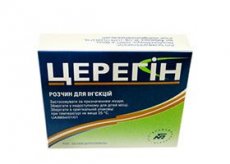Medical expert of the article
New publications
Preparations
Ceregin
Last reviewed: 03.07.2025

All iLive content is medically reviewed or fact checked to ensure as much factual accuracy as possible.
We have strict sourcing guidelines and only link to reputable media sites, academic research institutions and, whenever possible, medically peer reviewed studies. Note that the numbers in parentheses ([1], [2], etc.) are clickable links to these studies.
If you feel that any of our content is inaccurate, out-of-date, or otherwise questionable, please select it and press Ctrl + Enter.

Neuroprotective agent. Used to treat cerebrovascular disorders. The drug has a positive effect on intracellular metabolism, protects brain cells from the negative effects of toxic substances, and also has a neuromodulatory effect.
 [ 1 ]
[ 1 ]
Indications Ceregina
Indications for the use of Ceregin are as follows:
- Ischemic stroke (in the acute phase and in the rehabilitation period).
- Decreased memory and mental performance.
- Intellectual disability.
- Disorders of thinking.
- Absent-mindedness.
- Cerebrovascular insufficiency.
- Senile dementia.
- Post-traumatic conditions of the brain (damage to the skull and its contents due to trauma, post-operative rehabilitation period due to surgical treatment of areas of the brain).
- Dementia of various etiologies.
- Endogenous depression.
 [ 2 ]
[ 2 ]
Release form
Ceregin is produced exclusively as a solution for injection and infusion. Transparent liquid with a yellowish tint in white glass ampoules with a volume of 1 ml No. 10 or 5 ml No. 5 in polyvinyl chloride (PVC) blister trays, packed in original factory cardboard packaging.
Pharmacodynamics
Whey protein is the active ingredient of Ceregin. The raw material for obtaining hydrolysate is the brain of pigs and cattle.
The multicomponent medicinal product contains bioactive compounds, low-molecular neuropeptides, capable of overcoming the physiological barrier between the circulatory system and the central nervous system, directly reaching the neurons of the brain.
Enhances the protective function of neuronal tissue from the pathological effects of lactacidemia. Prevents the occurrence of free radicals, the development of neurodegenerative phenomena in brain tissue.
Intensive trophic activity is realized by inhibiting, sometimes stopping neuronal degenerative processes in the brain. It has a positive effect in the presence of cognitive disorders, has a positive effect on the processes of memorization, concentration and transmission of information, activates mnestic functions, has a neuromodulatory function.
Pharmacokinetics
The pharmacokinetic action of the drug cannot be studied due to its multicomponent nature.
Dosing and administration
Ceregin is used exclusively in the form of intramuscular injections from 1 to 5 ml and intravenous drip infusions from 10 to 50 ml. The dosage and duration of the treatment cycle depend on the severity and nature of the disease, the dynamics of therapy and the age of the patient.
The usual duration of treatment is 1 month (minimum number of injections is 5 per week, but preferably daily)
In case of cerebral lesions, acute cerebral circulatory failure, postoperative period, the drug is administered daily intravenously by drip in an adult dosage of 10-50 ml per day per 100-250 ml of saline solution for 1-1.5 hours. The treatment cycle is from 10 to 25 days.
During the rehabilitation period after OMNC, adult patients are typically prescribed 5 to 10 ml/day intravenously for 20 days or 1 month, depending on the dynamics.
For dementia of vascular origin for adults 20-30 ml per 100-200 ml of saline. Duration of administration - 20 injections.
Use Ceregina during pregnancy
Due to the fact that studies on the use of Ceregin during gestation or lactation have not been conducted, the drug is not prescribed.
Contraindications
- hypersensitivity to the drug substances,
- pathologies of the genitourinary system,
- pregnancy period,
- breastfeeding period,
- convulsive readiness.
Side effects Ceregina
Aggression, overexcitement, insomnia, confusion.
Nausea, gastrointestinal disorders, diarrhea, vomiting.
Local allergic reactions (hyperemia, itching, fever).
Hypersensitivity reactions are possible – headache, rash, rapid and difficult breathing, pain in the neck, anaphylactic shock.
When Ceregin is administered at high speed – fever, vertigo, hand tremors, arrhythmia
It is necessary to use Ceregin very carefully in patients prone to allergic diathesis. Do not use the drug with solutions that can change the acidity level of Ceregin or contain fats.
Overdose
To date, there have been no reports of drug overdose.
 [ 3 ]
[ 3 ]
Storage conditions
Store in the usual way - in a dark room with an air temperature of no more than 20 o C. Do not freeze. Keep out of reach of children.
Shelf life
The production date and expiration date are indicated on the factory packaging. When stored properly, the product is good for 36 months.
Attention!
To simplify the perception of information, this instruction for use of the drug "Ceregin" translated and presented in a special form on the basis of the official instructions for medical use of the drug. Before use read the annotation that came directly to medicines.
Description provided for informational purposes and is not a guide to self-healing. The need for this drug, the purpose of the treatment regimen, methods and dose of the drug is determined solely by the attending physician. Self-medication is dangerous for your health.

